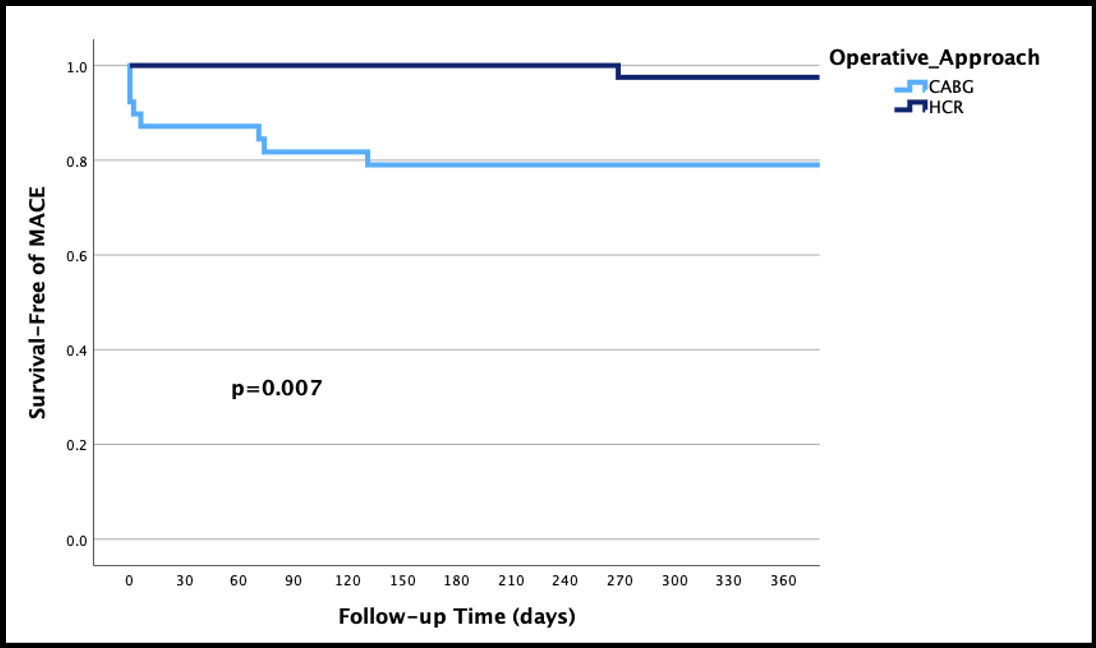Final ID: Mo4089
Hybrid Coronary Revascularization versus Traditional Coronary Artery Bypass Grafting for Left Main Disease
Abstract Body (Do not enter title and authors here): Background:
The current guideline-recommended intervention for left main (LM) disease is coronary artery bypass grafting (CABG). Hybrid coronary revascularization (HCR) combines robotic coronary artery bypass and percutaneous coronary intervention (PCI) and offers a less invasive approach for patients with LM and multivessel coronary artery disease. We aim to compare clinical outcomes at 30 days, 6 months and 1 year between HCR and CABG in patients with LM disease.
Methods:
We retrospectively screened 761 patients who underwent bypass for LM disease between 2019 and 2023 at a single institution. A total of 118 patients who underwent either HCR (n=59) or CABG (n=59) were included after propensity matching for baseline characteristics. The primary endpoint was major adverse cardiovascular events (MACE), defined as death, myocardial infarction, repeat revascularization and stroke, at 30 days, 6 months and 1 year, which was assessed using chi-squared tests. Secondary outcomes are individual components of MACE at 30 days, 6 months and 1 year. Kaplan-Meier curves were used to visualize the difference in 1-year cumulative MACE-free survival across groups coupled with a log-rank test.
Results:
The mean age was 68.93±11 years for HCR patients and 68.41±10.11 years for CABG patients (p=0.394). SYNTAX score was high (> 33) for 49.1% of HCR patients and 67.3% of CABG patients (p=0.15). Hospital length of stay was shorter for HCR compared to CABG (4.07 ± 1.21 days vs. 7.58 ± 7.71 days, p<0.001). MACE events were significantly lower in the HCR group at 30 days (0% vs 10.2%; p=0.01), 6 months (0% vs 17%; p=0.002) and 1 year (2.4% vs 20.5%; p=0.01). The cumulative MACE-free survival at 1 year was significantly higher in the HCR group (p=0.007). There were no significant differences in secondary outcomes at any time point with the exception of lower repeat revascularization at 6 months in the HCR group (0% vs 10.9%; p=0.02).
Conclusion:
This retrospective study demonstrates that HCR is a viable alternative to CABG for LM disease. While randomized clinical trial data is still needed, this less invasive approach is a promising treatment strategy for patients with high surgical risk.
The current guideline-recommended intervention for left main (LM) disease is coronary artery bypass grafting (CABG). Hybrid coronary revascularization (HCR) combines robotic coronary artery bypass and percutaneous coronary intervention (PCI) and offers a less invasive approach for patients with LM and multivessel coronary artery disease. We aim to compare clinical outcomes at 30 days, 6 months and 1 year between HCR and CABG in patients with LM disease.
Methods:
We retrospectively screened 761 patients who underwent bypass for LM disease between 2019 and 2023 at a single institution. A total of 118 patients who underwent either HCR (n=59) or CABG (n=59) were included after propensity matching for baseline characteristics. The primary endpoint was major adverse cardiovascular events (MACE), defined as death, myocardial infarction, repeat revascularization and stroke, at 30 days, 6 months and 1 year, which was assessed using chi-squared tests. Secondary outcomes are individual components of MACE at 30 days, 6 months and 1 year. Kaplan-Meier curves were used to visualize the difference in 1-year cumulative MACE-free survival across groups coupled with a log-rank test.
Results:
The mean age was 68.93±11 years for HCR patients and 68.41±10.11 years for CABG patients (p=0.394). SYNTAX score was high (> 33) for 49.1% of HCR patients and 67.3% of CABG patients (p=0.15). Hospital length of stay was shorter for HCR compared to CABG (4.07 ± 1.21 days vs. 7.58 ± 7.71 days, p<0.001). MACE events were significantly lower in the HCR group at 30 days (0% vs 10.2%; p=0.01), 6 months (0% vs 17%; p=0.002) and 1 year (2.4% vs 20.5%; p=0.01). The cumulative MACE-free survival at 1 year was significantly higher in the HCR group (p=0.007). There were no significant differences in secondary outcomes at any time point with the exception of lower repeat revascularization at 6 months in the HCR group (0% vs 10.9%; p=0.02).
Conclusion:
This retrospective study demonstrates that HCR is a viable alternative to CABG for LM disease. While randomized clinical trial data is still needed, this less invasive approach is a promising treatment strategy for patients with high surgical risk.
More abstracts on this topic:
Artificial Intelligence for Predicting Primary Antegrade Wiring Success of Chronic Total Occlusion Crossing
Alexandrou Michaella, Alaswad Khaldoon, Basir Mir, Davies Rhian, Jaffer Farouc, Nicholson William, Azzalini Lorenzo, Gorgulu Sevket, Khatri Jaikirshan, Bangalore Sripal, Rangan Bavana, Rempakos Athanasios, Mastrodemos Olga, Burke M Nicholas, Sandoval Yader, Brilakis Emmanouil, Mutlu Deniz, Strepkos Dimitrios, Carvalho Pedro, Al-ogaili Ahmed, Bahbah Ali, Anastasios Milkas, Tsiafoutis Ioannis
Association of renal function with mortality and heart failure hospitalization rates after Transcatheter Mitral Valve Edge to Edge RepairAbuzeid Wael, Shuvy Mony, Cantor Warren, Mehta Shamir, Fam Neil, Abdel-qadir Husam, Sacoransky Ethan, Czarnecki Andrew, Ke Danny Yu Jia, Teng Carolyn, Dave Prasham, Osten Mark, Zile Brigita, Wang Xuesong

